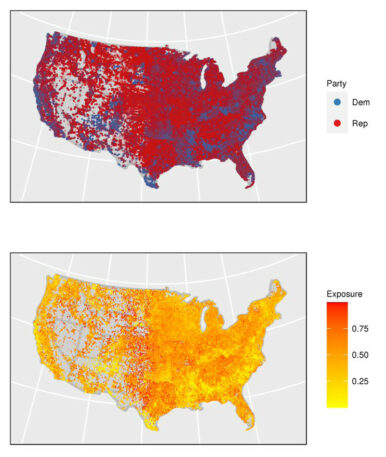
13 Mar Your partisan filter bubble is now following you around in the real world
We know that Republicans and Democrats for the most part don’t play nice with each other on social media, but a new study by Harvard researchers shows that they don’t even like living near each other in the real world.
“Our results show high partisan segregation across the country, with most voters of both political parties living in partisan bubbles with little exposure to the other party,” write Harvard political scientist Jacob Brown and statistician Ryan Enos in a report of the results of their four-year study. “These high levels of isolation exist in different types of regions and at different population densities.”
The researchers found that Democrat exposure to Republicans is on average lower than Republican exposure to Democrats, and markedly lower in high- and medium-population densities. They found that Republicans in rural areas are even more isolated from Democrats in rural parts of the country.
To arrive at their results, Brown and Enos used a unique approach. Instead of just analyzing the geographic locations of voter groups in aggregate, they were able to use geospatial data to measure the distance from a person of one party to the nearest neighbor from the opposing party. They pulled the voting and demographic data from the entire U.S. voter file, which contains data on 180 million people.
Brown and Enos found that when Democrats and Republicans live in the same city—or even the same neighborhood—they tend to bunch up based on their political party.

“A large proportion of voters live with virtually no exposure to voters from the other party in their residential environment,” they write. “Democrats and Republicans living in the same city, or even the same neighborhood, are segregated by party.”
In big cities, the most isolated 10% of Democrats will encounter other Democrats 93% of the time, while the same can be said of the most isolated Republicans in rural areas.
And partisan segregation isn’t simply a byproduct of social grouping for other reasons. “In general, for voters of both parties, high levels of segregation . . . are distinct from, and sometimes in tension with, racial segregation,” the researchers write.
Red and blue fences
Even if Americans could step outside the hyperpartisanship and culture wars and meet each other for a proverbial “back fence conversation,” they’re more likely than ever to find only a person with complementary views standing on the other side. The same echo chambers encouraged by the algorithms of social networks remain intact where people live and work.
Social media has greatly affected the way Americans get their news and information: It’s very easy to arrive with your own set of political beliefs and find a whole news ecosystem that affirms those beliefs and rarely challenges them. So when people from opposing parties attempt to talk about political issues, they often find that they’re arguing using two different sets of facts.
But it’s also true that social media users make intentional choices about the political content they see. They may unfriend or mute an acquaintance with political beliefs they don’t share. Many of the posts they see are shared by friends or family with similar social backgrounds, and therefore similar political beliefs.
The continued segregation of people with different party affiliations could have a direct impact on the way voting districts are drawn, says Benjamin Schneer, an assistant professor of public policy at the Harvard Kennedy School.
“When partisans all live together in a concentrated area, the way lines are drawn matters more—and with that comes the possibility of gerrymandering,” Schneer says. “On the other hand, in a case where partisans are perfectly intermingled, it doesn’t really matter how districts are drawn.”
In this country, politics are often closely tied to social and cultural identities, as much as or more than race or religion, the researchers point out. Our party affiliation usually says a lot about how we act and what we believe, both within the political realm and outside of it. If we are rarely or never confronted with political beliefs or worldviews that challenge our own, polarization continues, and two very different kinds of Americans (red and blue, liberal and conservative) continue to develop and evolve independently of one another.
That doesn’t bode well for democracy. And even more disturbingly, the lack of direct discourse makes it far easier for members of one group to dehumanize the members of the opposing group.
Neo-authoritarian politicians such as Donald Trump encourage such partisan division and draw power from it. In fact, it’s likely that Trump could only have risen to power in a culture as divided as ours.
Brown and Enos’s findings suggest that our polarization problem is as fixed as our residential address and unlikely to evolve and improve anytime soon.
Source: Fast Company




Sorry, the comment form is closed at this time.